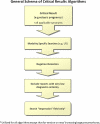Automated detection of critical results in radiology reports
- PMID: 22038514
- PMCID: PMC3264731
- DOI: 10.1007/s10278-011-9426-6
Automated detection of critical results in radiology reports
Abstract
The goal of this study was to develop and validate text-mining algorithms to automatically identify radiology reports containing critical results including tension or increasing/new large pneumothorax, acute pulmonary embolism, acute cholecystitis, acute appendicitis, ectopic pregnancy, scrotal torsion, unexplained free intraperitoneal air, new or increasing intracranial hemorrhage, and malpositioned tubes and lines. The algorithms were developed using rule-based approaches and designed to search for common words and phrases in radiology reports that indicate critical results. Certain text-mining features were utilized such as wildcards, stemming, negation detection, proximity matching, and expanded searches with applicable synonyms. To further improve accuracy, the algorithms utilized modality and exam-specific queries, searched under the "Impression" field of the radiology report, and excluded reports with a low level of diagnostic certainty. Algorithm accuracy was determined using precision, recall, and F-measure using human review as the reference standard. The overall accuracy (F-measure) of the algorithms ranged from 81% to 100%, with a mean precision and recall of 96% and 91%, respectively. These algorithms can be applied to radiology report databases for quality assurance and accreditation, integrated with existing dashboards for display and monitoring, and ported to other institutions for their own use.
Figures





References
-
- Patient safety requirement 2 C (standard NPSG.2a). In: The 2007 Comprehensive Accreditation Manual for Hospitals: The Official Handbook. Oakbrook Terrace, IL: Joint Commission Resources, 2007, pp NPSG-3–NPSG-4
-
- American College of Radiology: ACR Practice Guideline for Communication of Diagnostic Imaging Findings. In: Practice Guidelines & Technical Standards 2005. Reston, VA: American College of Radiology, 2005
-
- Hersh WR, Detmer WM, Frisse ME. Medical Informatics. New York, NY: Springer; 2001. Information-retrieval systems; pp. 539–572.
Publication types
MeSH terms
LinkOut - more resources
Full Text Sources

